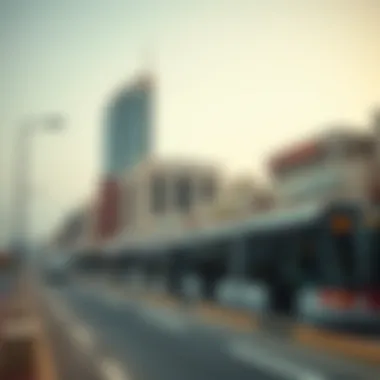Metro Accessibility and Its Impact on Al Seef Real Estate


Intro
When it comes to navigating the sprawling urban landscape of Dubai, few infrastructures hold as much sway over the real estate market as the metro system. Al Seef, a vibrant mix of culture, modernity, and a growing residential hub, is currently witnessing a significant transformation. The proximity and efficiency of metro services can drastically shape the lifestyle of its residents and visitors alike.
In this exploration of metro connectivity around Al Seef, we will delve deep into how these factors impact property values and urban mobility. As we peel back the layers, we aim to provide a clear view of the operational nuances of nearby metro stations, dissecting their importance for everyone from investors seeking lucrative opportunities to newcomers trying to find a place to call home.
Understanding the role of metro accessibility in real estate dynamics is crucial, especially in a city like Dubai, where demand for housing surges alongside its rapid developments. Keep reading as we navigate through essential insights, property price analyses, and investment strategies that people—whether seasoned investors or first-time homebuyers—should consider when exploring opportunities within Al Seef and its surrounding neighborhoods.
Understanding Al Seef's Location
Al Seef, a vibrant area along the Dubai Creek, is a strategic spot that blends history with modernity. When discussing real estate dynamics, it's vital to grasp Al Seef's location. Its geographical positioning offers a gateway to various city attractions, making it a sought-after locale for potential residents, investors, and visitors alike.
Geographical Overview
This location boasts wide-ranging amenities and connectivity. Nestled between traditional markets and modern retail spaces, it provides a unique juxtaposition of cultures. Al Seef runs parallel to the waterway, offering not only scenic views but also access to numerous transportation routes, aiding in seamless navigation across the city. The proximity to Downtown Dubai and the Dubai International Airport certainly adds a cherry to its attractive pie.
The area is well connected to road networks, such as Sheikh Zayed Road, allowing swift journeys to major districts. Furthermore, the Al Seef's development plan places emphasis on preserving indigenous architectural styles, which enhances the area's charm and appeal. All of these elements contribute to its identity, showcasing why it's pivotal to understand Al Seef's geographical canvas in the broader narrative of Dubai's real estate.
Significance in Dubai's Urban Fabric
The significance of Al Seef in the urban landscape of Dubai cannot be overstated. This area embodies the spirit of community blended with the pulse of tourism. As a multifaceted locale, it's not just about residential properties; it also houses businesses, cultural venues, and recreational spots that attract both locals and tourists effectively.
One aspect worth noting is that residential units in Al Seef tend to hold their value, thanks in part to the flourishing popularity of the region. Additionally, being surrounded by other vital areas — like Deira and Bur Dubai — means that residents have a variety of options for shopping, dining, and entertainment at their doorsteps.
The strategic significance of Al Seef amplifies its visibility in the real estate market, making it an attractive proposition for investors who wish to delve deep into Dubai's ever-evolving urban narrative.
This blend of accessibility, culture, and lifestyle available in Al Seef makes it a noteworthy focal point for anyone interested in the dynamics of Dubai's real estate market. Understanding this location isn't just about knowing its physical attributes but also recognizing its socio-economic ramifications in the broader context of Dubai's urban development.
Metro Connectivity in Dubai
Metro connectivity stands as a cornerstone of urban transport in Dubai, offering an intricate web of lines that help to ease the flow of commuters across this bustling metropolis. As one of the most rapidly urbanizing regions globally, the significance of a reliable metro system cannot be overstated, especially when looking at neighborhoods like Al Seef, where urban living blends with cultural richness.
The metro does more than just ferrying people from point A to point B; it plays a vital role in shaping the real estate landscape. With the ongoing development of properties in close proximity to metro stations, many savvy investors are keeping a keen eye on the implications of this transit system. A well-connected location often leads to increased demand for housing, thus influencing property values in the area. Factors such as commute times, connectivity to business districts, and access to amenities are pivotal considerations that impact buyer choices.
Moreover, metro connectivity also factors into the broader urban mobility plans that aim to minimize congestion on the roads. By offering an efficient alternative to cars, it encourages sustainable practices and a reduction in carbon footprint. As such, for any prospective resident or investor, understanding the ins and outs of the metro system is paramount.
An Prelude to the Metro System
Dubai’s metro system first opened to the public in 2009, a significant milestone in the city’s transportation history. What began with a single line rapidly expanded, evolving into a comprehensive network with two primary lines: the Red Line and the Green Line. Together, they span over 90 kilometers, intertwining with Dubai’s most significant commercial and residential districts.
The metro is known for its punctuality. Trains run frequently, providing commuters with the flexibility to travel without long waits. Over the years, the network has seen expansions that improve not only accessibility but also connectivity to key lifestyle areas. For instance, the integration with the tram system in areas like Dubai Marina allows smooth transitions between different modes of public transport for those commuting in and out of Al Seef.
Key Features of Dubai's Metro Network
Dubai’s metro system is laden with features that enhance user experience:
- Automated System: The trains are driverless, which ensure a high level of safety and reliability.
- Affordable Fares: The cost of traveling on the metro is economical, promoting public transport as a viable alternative to driving.
- Diverse Coverage: It connects major tourist attractions, business hubs, and important residential neighborhoods, making it versatile for all users.
- Modern Stations: The stations are designed with user comfort in mind, and many include retail shops, cafes, and waiting areas that add to the overall experience.
- Smart Technology: Features like real-time tracking of trains, touchless payment options, and digital screens provide passengers with essential information at their fingertips.
Each of these elements ties into the greater purpose of making commuting an effortless part of living in Dubai, especially surrounding vibrant areas such as Al Seef.


"Metro connectivity is not just about transit; it's about seamless integration into the urban fabric of Dubai."
With these features working in tandem, the metro system becomes much more than simple transport; it is a fundamental part of the urban experience in Dubai and significantly impacts real estate trends around communities like Al Seef.
Nearest Metro Station to Al Seef
Understanding the nearest metro station to Al Seef is paramount for anyone involving themselves in the Dubai real estate market. The station not only contributes to the transportation convenience for residents but also holds sway over property values in the area. Easy access to public transit can be a game-changer for buyers and investors alike. As the population continues to swell, the demand for transport options becomes crucial, making this topic worth a deep dive.
Metro Station Overview
The nearest metro station to Al Seef is the Burjuman Metro Station. Situated at a strategic junction, this station connects the Red and Green lines, providing vital links to various parts of the city. For residents, stepping off the train and being a stone's throw away from their homes speaks volumes about lifestyle convenience.
Burjuman Station boasts modern facilities, including ticket kiosks and information screens, which add to the overall travel experience. It's not merely a stop; it's a hub that channels commuters into the vibrant life surrounding Al Seef, effortlessly connecting them to shopping, dining, and business districts.
Distance and Accessibility Details
Bah, when it comes to distance, it’s practically a hop skip away. The Burjuman Metro Station is about one to two kilometers from the heart of Al Seef, easily reachable on foot or by a quick taxi ride. This proximity enhances the appeal of living in Al Seef since you won’t need to wrestle with long commutes.
- Walking Distance: Approximately 15-20 minutes on foot, depending on your pace.
- Taxi Ride: A mere five to seven minutes, depending on traffic.
Moreover, the area caters to pedestrian-friendly pathways, ensuring residents can enjoy strolls without hassle. The integration of cycling paths presents another nifty option for those feeling adventurous.
Operating Hours and Frequency
Now, talking about the nitty-gritty of operating hours, the Dubai metro is known for its reliability.
- Operating Hours:
- Sunday to Wednesday: 6 AM to 12 AM (midnight)
- Thursday: 6 AM to 1 AM (the next day)
- Friday: 8 AM to 1 AM (the next day)
- Saturday: 6 AM to 12 AM (midnight)
Trains generally run every 7-10 minutes during peak hours, making sure no one is left standing on the platform for too long. Commuters can depend on efficient services that keep the rhythm of their day-to-day commute smooth as silk. This capability not only makes for a seamless travel experience but can also bolster interest in local real estate, as both investors and buyers look for properties that offer state-of-the-art transport links.
The accessibility provided by Burjuman Metro Station can significantly influence the desirability of property in Al Seef; a well-connected area often sees a higher demand and better prices.
In summary, the Burjuman Metro Station's impact on commuting and connectivity in Al Seef cannot be overstated. The station is poised to affect not just the way residents navigate the city but also the larger dynamics within the real estate landscape.
Impact on Property Values
Understanding how metro accessibility impacts property values is critical in the broader conversation surrounding Al Seef's real estate market. As a hotspot in Dubai, A l Seef's connection to the metro reflects not just convenience for residents but also shapes the economic landscape. The proximity to public transportation often plays a pivotal role in determining market desirability, influencing factors like purchase prices, lease rates, and overall demand. Investors, homeowners, and real estate agents should take note—accessibility can either enhance or dampen property appeal, impacting investment returns and living experiences.
Correlation Between Metro Access and Property Prices
A closer look at the correlation between metro access and property prices reveals a clear trend: properties near metro stations tend to command higher values. A study focusing on various neighborhoods in Dubai supports this assertion, showing that homes within a 500-meter radius of metro stations often see a price premium ranging from 10% to 20%.
Factors at play include the convenience of commuting. For many residents, saving time during daily commutes can significantly influence their housing decisions. The Al Seef neighborhood boasts easy access to metro stations, making it an attractive option for professionals working in bustling business districts like Dubai Marina or Downtown Dubai.
- Amenities available nearby also play a role. Due to increased foot traffic from commuters, local businesses thrive, which in turn elevates the neighborhood's appeal.
- Quality of life factors come into play. Residents appreciate the freedom of public transport rather than solely relying on personal vehicles, contributing to a trend where homes near metro stations are not just properties but lifestyle choices.
Comparative Analysis with Other Neighborhoods


When placing Al Seef's property values under a microscope, it’s insightful to compare these values against other neighborhoods in Dubai. Take Dubai Marina and Jumeirah Lake Towers as examples, both known for their vibrant scenes and proximity to metro lines.
Properties in these neighborhoods also demonstrate elevated price points due to metro access, serving as a benchmark. Here's how Al Seef stacks up:
- Proximity to Urban Centers: Unlike some peripheral neighborhoods, Al Seef is nestled close to the heartbeat of Dubai, where commodities and cultural attractions thrive.
- Development Continuity: Although neighboring areas like Dubai Marina have established prestige, Al Seef continues to evolve, showing promise for long-term increases in property values.
- Investor Appeal: Investors may flock to Al Seef for its comparatively lower entry prices while capitalizing on upcoming infrastructure improvements. This potential can lead to significant returns as the neighborhood continues to develop.
“Metro access transforms a neighborhood—it's not just about transport, it's about lifestyle, amenities, and ultimately, value.”
Resident Perspectives
When we talk about Resident Perspectives, it’s not just a side note; it’s the crux of what makes a neighborhood truly livable. For those considering relocating to Al Seef or investing in its property market, understanding how the local metro system influences daily life is paramount. For residents, close proximity to public transport can significantly enhance their quality of life. The convenience of hopping on a metro rather than navigating congested roads can be a game-changer, especially for expatriates or anyone new to the hustle and bustle of Dubai.
Residents express a blend of gratitude and hope when discussing their commuting experiences and housing preferences. They often cite feelings of connectedness to the rest of the city, thanks to reliable metro access. This connectivity plays a pivotal role not only in daily commutes but also in social engagements and overall well-being. Let’s break down this journey into two key aspects: commuting experiences for residents and their housing decisions.
Commuting Experience for Residents
For many, commuting in Dubai is a double-edged sword. On one hand, the city's infrastructure is designed to facilitate smooth travel; on the other hand, the sheer volume of traffic can lead to frustration. Residents near the metro station in Al Seef have an edge. The convenience of the metro leads to shorter commute times, which many local residents appreciate. On average, those living near the Al Seef metro station enjoy a commute that could take as little as fifteen minutes to reach pivotal spots like Downtown Dubai or Dubai Marina.
With the metro being so accessible, residents often report leveraging this convenience to explore more parts of the city. Rather than being confined to their immediate neighborhoods, they venture to cultural hotspots or recreational areas with ease. This aspect creates a vibrant community where social activities thrive, and peer connections flourish. In a city as dynamic as Dubai, this sort of mobility contributes to a deeper sense of belonging and community engagement.
Preferences and Priorities in Housing Decisions
When it comes to housing choices, metro accessibility often intertwines with other preferences. It appears that residents have come to prioritize properties within walking distance to metro stations, equating this proximity with value.
Several factors influence their housing decision processes:
- Convenience: Proximity to transport options is at the top of the list. Many favor that sweet spot of being just steps away from the metro.
- Safety and Environment: A well-lit, safe area around metro stations appeals to families and young professionals alike.
- Vibrancy of Lifestyle: Areas near metro stations often feature cafes, shops, and recreational spaces. It’s not just about where they live; it’s about the experiences they can have nearby.
- Future Growth Prospects: Investors and homebuyers are inclined to choose neighborhoods projected to grow. Being close to transit lines often means better long-term equity, something all housing seekers keep in mind.
In summary, Resident Perspectives shed light on the dynamic relationship individuals have with their living environments in Al Seef. Access to metro services influences not only the commuting experiences of residents but also their overall housing choices and, ultimately, their life satisfaction and community involvement. The importance of examining these perspectives cannot be understated, as they provide invaluable insights into the broader implications of urban planning and real estate development.
Broader Urban Mobility Considerations
Understanding urban mobility goes beyond just getting from point A to point B. It includes how different transport systems interact, the economies they affect, and the impact on the everyday lives of residents and visitors alike. In the context of Al Seef, integrated mobility can significantly elevate its attractiveness as a residential and commercial hub.
Transport systems are intricately linked. When a metro line is implemented, it’s often paired with bus routes, tram services, and even ride-sharing options. This integration not only ensures ease of movement but also enriches the experience of living or visiting a neighborhood. Al Seef is strategically positioned to benefit from such synergies, promoting a seamless flow for commuters. The convenience is palpable: taking the metro to the nearest station and easily transitioning to a bus service can drastically cut down on travel time, a crucial consideration in a bustling city like Dubai.
- Benefits of Integrated Mobility:
- Enhanced accessibility across the city
- Fostering economic growth by increasing foot traffic in businesses
- Reduction in traffic congestion as more people opt for public transport
- Promotion of social interactions, as areas become more reachable and connected
In addition, urban mobility considerations are becoming increasingly vital as cities evolve. Places like Al Seef are no longer viewed solely as residential zones; they are emerging as vibrant communities that thrive on interaction. For investors and developers, understanding how metro connectivity influences these aspects can inform better decision-making and strategic planning in real estate investments.
"The future of urban living is about connection, and effective transport systems play a pivotal role in knitting the urban fabric together."
Integration with Other Public Transport Options
The integration of various public transport modes is one of the cornerstones of effective urban mobility. Al Seef, situated close to key metro stations, stands as a prime example of how connectivity creates a network of convenience. This proximity enables local governance to enhance services such as buses, bicycles, and ride-sharing programs.
Buses frequently scheduled to coincide with metro arrivals minimize waiting times, while dedicated cycling paths encourage eco-friendly travel. The aim is not just about reducing reliance on cars but ensuring that there are numerous, efficient options that meet different commuter needs. An effective interchange between these transport modes can eliminate frustrating delays and enhance urban cohesion.


Some considerations regarding integration include:
- Schedules that sync with metro running times
- A variety of transport modes that appeal to diverse user demographics
- User-friendly apps that provide real-time information on transport availability
Effective integration enhances the living experience. Residents or visitors could unexpectedly decide on a spontaneous outing, unbothered by transport logistics due to the seamless connections in place.
Sustainability and Urban Planning Implications
Sustainability is central to modern urban planning, dictating how cities accommodate their growing populations. For Al Seef, the metro system opens up doors to sustainable practices. By reducing reliance on fossil fuels through public transit, the urban environment benefits, leading to lower emissions and improved air quality.
Incorporating sustainability measures into urban planning involves:
- Creating green spaces that reduce heat and offer recreational areas
- Using renewable energy sources for stations and transport modes
- Encouraging developers to consider eco-friendly designs in their projects
Furthermore, the urban planning implications stretch far beyond ecological benefits. Sustainable urban mobility can increase property values, as areas perceived as environmentally friendly become increasingly desirable. Investors and homeowners recognize that spaces powered by green technology and easily accessible public transportation hold significant appeal.
In sum, the interconnectedness of transport systems, urban mobility considerations, and sustainable practices forms the backbone of a thriving community around Al Seef. By nurturing these elements, Dubai can ensure that Al Seef not only remains a desirable place to live but also meets the challenges of future urbanization comprehensively.
Future Developments in Metro Infrastructure
The landscape of metro infrastructure in Dubai is continually evolving. The significance of future developments in this area cannot be overstated, especially as the city gears up to accommodate growing populations and bolster its status as a global hub. As investors and residents alike seek ways to navigate their commutes efficiently, accessibility becomes a linchpin in the real estate market surrounding Al Seef.
Planned Expansions and New Line Proposals
In recent discussions, there has been increasing chatter about potential expansions to the existing metro network. One notable proposal includes an extension of the Green Line to better serve the Al Seef area. This kind of planned expansion not only enhances commuter access but also synchronizes with Dubai's ambitious urban planning strategies. With additional lines, areas previously deemed remote become tethered to the heart of the city, enhancing both value and livability.
Benefits of Planned Expansions
- Increased Property Value: Properties in closer proximity to new metro stations can see a sharp rise in value. For instance, neighborhoods like Al Jaddaf and Al Quoz have experienced significant price hikes owing to metro connectivity improvements.
- Job Accessibility: New metro lines improve access to employment hubs, making it easier for homeowners and expatriates to commute to work, reducing travel time significantly.
- Tourism Boost: Extended metro options may attract tourists who benefit from accessible transportation to hotspots around the city, which in turn supports local businesses.
- Sustainability Goals: New developments align with Dubai’s initiatives to promote public transport as a greener alternative to the private vehicle, reducing congestion and pollution in the long term.
Potential Impact on Al Seef and Surroundings
As these metro expansions unfold, one can't help but ponder how they will ripple through Al Seef and its neighboring areas. Changes in infrastructure often bring about shifts in demographics, economic viability, and lifestyle choices.
Direct Effects on the Community
- Enhanced Commuting Options: Residents of Al Seef may find their commute shortened, granting them more leisure time. When one considers the daily grind, even a mere 10-15 minutes saved can significantly elevate quality of life.
- Greater Investment Interest: As property values rise, Al Seef may become increasingly attractive to both domestic and international investors. The opportunity for higher rental yields could push savvy investors to consider buying into this neighborhood.
- Transformation of Local Businesses: Shops and eateries may flourish as foot traffic increases due to metro accessibility. Local entrepreneurs will benefit from greater visibility and customer access.
- Urban Integration: Establishing new lines encourages the development of mixed-use projects that blend residential, commercial, and recreational spaces. This approach fosters vibrant communities where residents can live, work, and play without extensive travel.
End
Understanding the metro connectivity near Al Seef is not just an abstract academic exercise; it holds real-life implications for various stakeholders in Dubai's dynamic real estate market. Access to metro stations shapes daily life for residents, influencing their commuting patterns and overall convenience. For investors, reliable public transport systems can significantly affect property values, enhancing the attractiveness of neighborhoods like Al Seef.
Summary of Findings
The analysis throughout this article underscores several key points:
- Metro Proximity and Property Value: The relationship between being close to metro stations and increasing property prices has been acknowledged. Areas with better metro access typically see steady growth in real estate values.
- Insights from Residents: Feedback from residents reveals that convenient public transport options are a central component of their living satisfaction, impacting their choice of location.
- Urban Mobility Integration: The interplay between the metro system and other forms of public transport enriches residents’ ability to navigate the city smoothly, presenting Al Seef as an increasingly desirable location.
Implications for Investors and Residents
For residents, metro connectivity brings practical advantages. Shortened commute times and greater access to employment and leisure facilities enhance their quality of life. For investors looking to purchase properties in Al Seef, understanding these dynamics offers valuable insights. They can expect that properties near metro stations will have a higher demand, safeguarding their investment.
As the city continues to grow, properties that maintain close access to metro lines will likely see a more substantial appreciation over time. With upcoming infrastructure developments planned for the metro system, such as proposed expansions, the future potentially holds many more benefits for both residents and investors.
In essence, the ongoing developments in metro infrastructure are poised to shape not only the real estate landscape but also the lifestyle and choices of those who live and work in Dubai.







